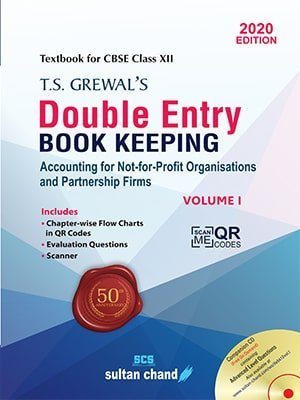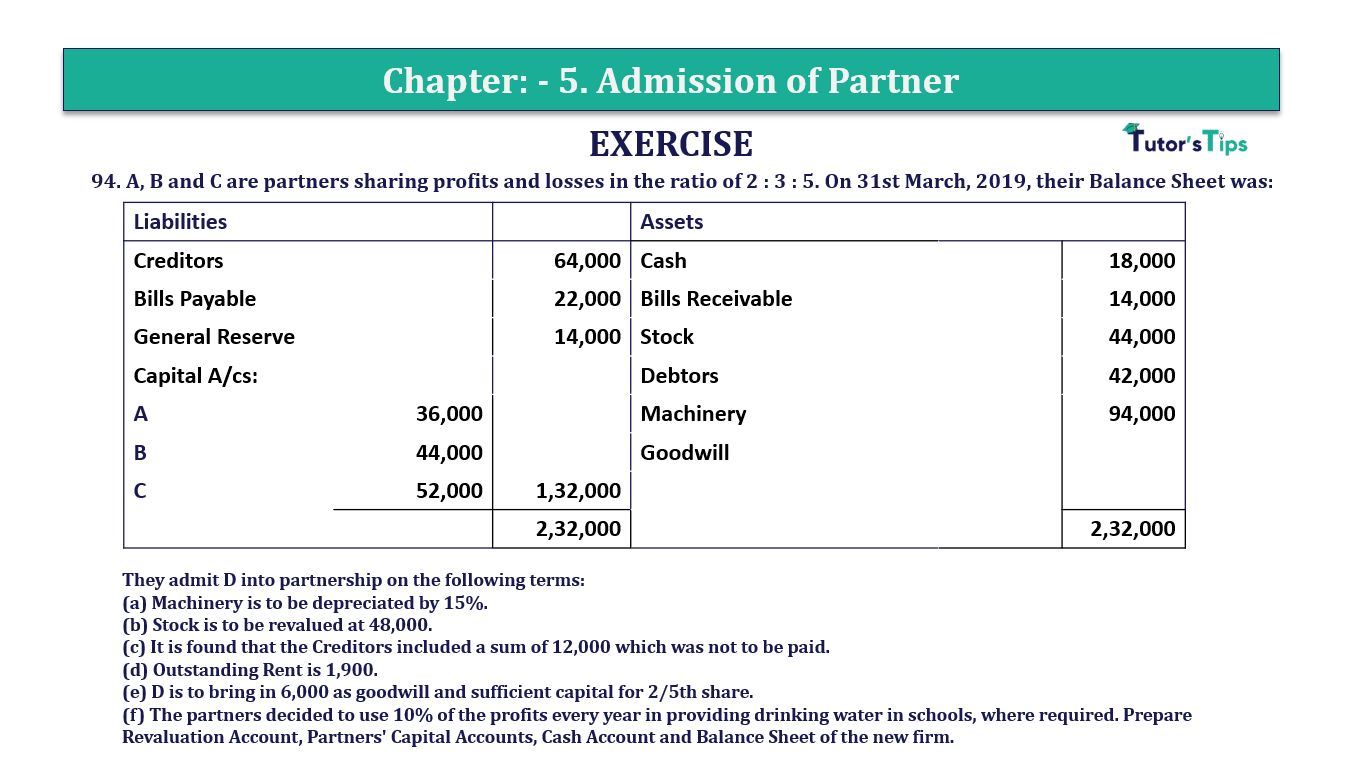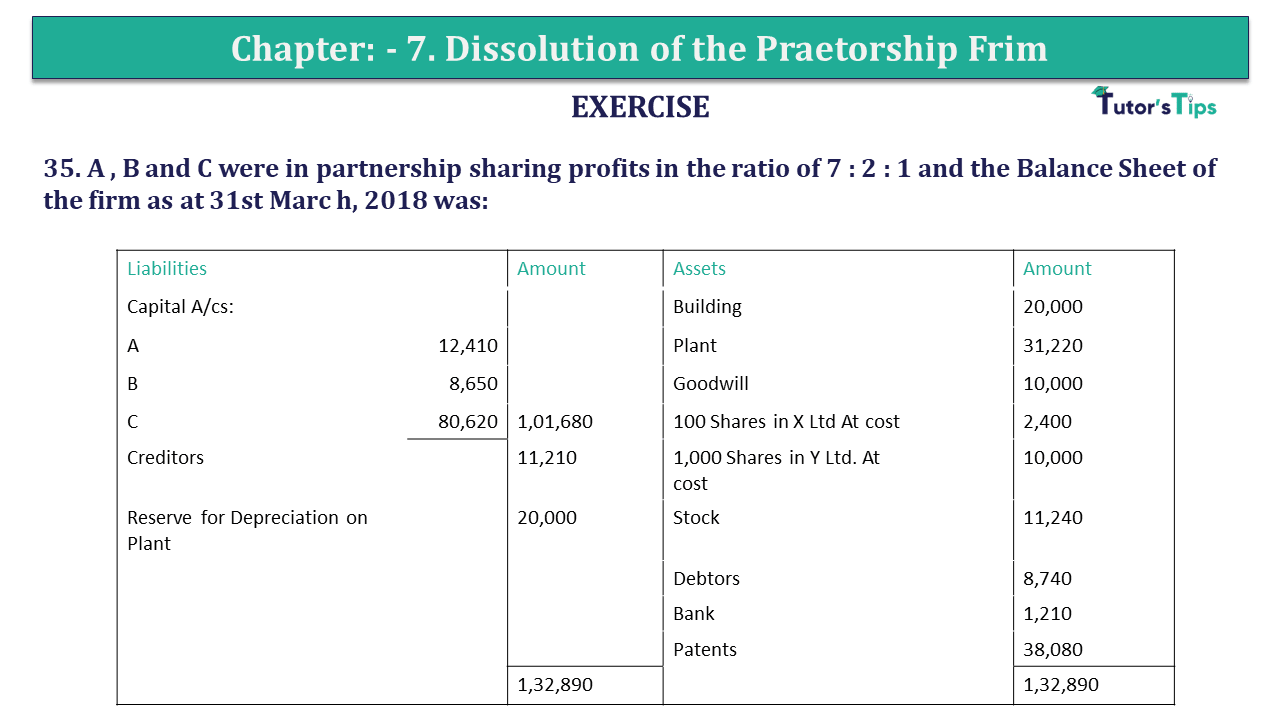Question 94 Chapter 5 of +2-A
94. A, B and C are partners sharing profits and losses in the ratio of 2 : 3 : 5. On 31st March, 2019, their Balance Sheet was:
| Liabilities | Assets | |||
| Creditors | 64,000 | Cash | 18,000 | |
| Bills Payable | 22,000 | Bills Receivable | 14,000 | |
| General Reserve | 14,000 | Stock | 44,000 | |
| Capital A/cs: | Debtors | 42,000 | ||
| A | 36,000 | Machinery | 94,000 | |
| B | 44,000 | Goodwill | ||
| C | 52,000 | 1,32,000 | ||
| 2,32,000 | 2,32,000 |
They admit D into partnership on the following terms:
(a) Machinery is to be depreciated by 15%.
(b) Stock is to be revalued at 48,000.
(c) It is found that the Creditors included a sum of 12,000 which was not to be paid.
(d) Outstanding Rent is 1,900.
(e) D is to bring in 6,000 as goodwill and sufficient capital for 2/5th share.
(f) The partners decided to use 10% of the profits every year in providing drinking water in schools, where required.
Prepare Revaluation Account, Partners’ Capital Accounts, Cash Account and Balance Sheet of the new firm.
The solution of Question 94 Chapter 5 of +2-A: –
| Revaluation Account |
|||||
| Particular |
Amount | Particular | Amount | ||
| To Machinery A/c | 14,100 | By Stock A/c | 4,000 | ||
| To Outstanding Rent A/c | 1,900 | By Creditors A/c | 12,000 | ||
| 16,000 | 16,000 | ||||
| Partners’ Capital Account |
||||
| Particulars | A | B | C | D |
| To Goodwill A/c | 4,000 | 6,000 | 10,000 | |
| To Balance c/d | 1,10,000 | 44,000 | 52,000 | 88,000 |
| 40,000 | 50,000 | 1,00,000 | 88,000 | |
|
Particulars |
A | B | C | D |
| By Balance B/d | 36,000 | 44,000 | 52,000 | |
| By Bank A/c (WN2) | – | – | – | 88,000 |
| By Premium for Goodwill A/c | 1,200 | 1,800 | 3,000 | – |
| By General Reserve A/c | 2,800 | 4,200 | 7,000 | – |
| 40,000 | 50,000 | 62,000 | 88,000 |
Advertisement-X
| Balance Sheet |
|||||
| Liabilities |
Amount | Assets | Amount | ||
| Creditors | 52,000 | Cash | (18,000 + 88,000 + 6,000) | 1,12,000 | |
| Bills Payable | 22,000 | Bills Receivable | 14,000 | ||
| Outstanding Rent | 1,900 | Machinery | 94,000 | ||
| Capital A/cs: | Less: Depreciation | 14,100 | 79,900 | ||
| A | 36,000 | Investments | 25,000 | ||
| B | 44,000 | Stock | 48,000 | ||
| C | 52,000 | Debtors | 42,000 | ||
| D | 88,000 | 2,20,000 | |||
| 2,95,900 | 2,95,900 | ||||
Working Note:-
Calculation of New profit-sharing ratio
D’s Share of Profits = 2/5
| Remaining share | = | 1 | – | 2 |
| 5 |
| = | 5 – 2 | |
| 5 |
| = | 3 | |
| 5 |
| A’s New Share of Profits | = | 3 | X | 2 |
| 5 | 10 |
| = | 6 | |
| 50 |
| B’s New Share of Profits | = | 3 | X | 3 |
| 5 | 10 |
| = | 9 | |
| 50 |
| C’s New Share of Profit | = | 3 | X | 5 |
| 5 | 10 |
| = | 15 | |
| 50 |
Advertisement-Y
A : B : C : D = 6 : 9 : 15 : 20
Calculation of D’s Capita
| Total Adjusted Capital of the Old Partners | = | A’s Capital + B’s Capital + C’s Capita |
| = | (36,000 + 44,000 + 52,000) | |
| = | 1,32,000 | |
| Combined New Share of the Old Partners | = | (9/50 + 15/50) |
| = | 30/50 or 3/5 |
Total Capital of the new firm = (Adjusted Capital of the Old Partners × Reciprocal of Combined New Share of the Old Partners)
| = | 1,32,000 | X | 5 | |
| 3 | ||||
| = | 2,20,000 |
D’s Capital = (Total Capital of the new firm × His Share of Profits)
| = | 2,20,000 | X | 2 | |
| 5 | ||||
| = | 88,000 |
T.S. Grewal’s Double Entry Book Keeping +2 (Vol. I: Accounting for Not-for-Profit Organizations and Partnership Firms)
- Chapter No. 1 – Financial Statement of Not-For-Profit Organisations
- Chapter No. 2 – Accounting for Partnership Firms – Fundamentals
- Chapter No. 3 – Goodwill: Nature and Valuation
- Chapter No. 4 – Change in Profit-Sharing Ratio Among the Existing Partners
- Chapter No. 5 – Admission of a Partner
- Chapter No. 6 – Retirement/Death of a Partner
- Chapter No. 7 – Dissolution of a Partnership Firm
T.S. Grewal’s Double Entry Book Keeping (Vol. II: Accounting for Companies)
- Chapter No. 8 – Company Accounts – Accounting for Share Capital
- Chapter No. 9 – Company Accounts – Issue of Debentures
- Chapter No. 10 – Redemption of Debentures
T.S. Grewal’s Double Entry Book Keeping (Vol. II: Accounting for Companies)
- Chapter No. 1 – Financial Statements of a Company
- Chapter No. 2 – Financial Statement Analysis
- Chapter No. 3 – Tools of Financial Statement Analysis – Comparative Statements and Common- Size Statements
- Chapter No. 4 – Accounting Ratios
- Chapter No. 5 – Cash Flow Statement
Check out T.S. Grewal +2 Book 2020@ Official Website of Sultan Chand Publication
Advertisement-X








Leave a Reply